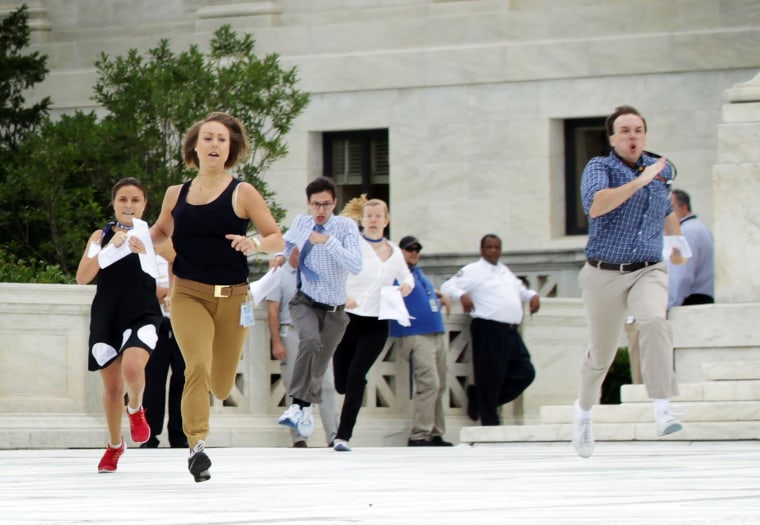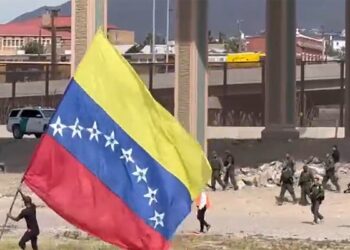If knowledge is power in Washington, then some of the most powerful people, for a moment every year, were once the sweaty young interns who knew before the rest of the world whether same-sex marriage was legal or the fate of health care as they literally raced to deliver paper copies of Supreme Court decisions to TV correspondents waiting in the summer heat.
Their only weakness was the risk of face-planting on national television in front of all their bosses and colleagues.
The so-called “running of the interns” was the fastest way for the world to find out about a Supreme Court ruling in the paper era. And the faster they ran, the faster the news got out.
But now that the high court is finally entering the internet era, decisions are posted online immediately. So the interns have stopped running and the high-stakes annual nerd race is going the way of the once-ubiquitous pay phones inside the nearby Capitol, where reporters would race to dictate news to their home offices before competitors.
“Do I lament the fact that Supreme Court decisions are more widely available and transparent? Of course not,” said Pete Williams, who retired in 2022 after decades covering the court for NBC News. “Undeniably though, it drains a little bit of the drama, when you are standing outside the court and America is hanging on your every word. Those days are kind of gone.”
During the pandemic, the court stopped meeting in person and decisions were posted exclusively online as the justices spoke on a conference call. Today, the paper hard copies are back in the building, but there’s no real need for the intern track-and-field program since decisions are posted online immediately (though a few still run to provide copies for the correspondents who prefer to read on paper instead of on iPads).
Monday morning, the court will deliver its final decisions of the term, including the much-anticipated decision about whether Donald Trump enjoys immunity in his criminal prosecutions, but it’ll be a PDF, not paper copy, that gets the news to most people.
Court watchers and former running interns agree the change is for the better, making the infamously traditional high court more accessible to the public. But they also agree there’s something romantically analog about the tradition that they’ll miss.

The roughly quarter-mile footrace from the court’s public information office deep inside the building to the TV cameras outside was “sort of the platonic ideal of what journalism is” — literally bringing the news to the people — said Jess McHugh, who was a running intern for CNN in 2014 and is now a Paris-based journalist and author.
“Once you say something, it sort of makes it true in the world. So whether it’s good news or bad news, you’re in this liminal space of news as you run it,” McHugh said. “Insofar as an asthmatic nerd can take any kind of running seriously, I did take it very seriously.”
Before everything went online, runners were long employed by newsrooms, government agencies and others needing to move information quickly. The Supreme Court’s “running of the interns” first rose to widespread national prominence on the night of the Bush v. Gore decision in 2000, when the court was put in the unprecedented position of essentially deciding a presidential election.
Cable news was still relatively young and competition was fierce. Millions of Americans tuned in to the news networks, anxiously waiting for an update from court. Then, as now, cameras were not allowed inside the court.
Then, like white smoke above the Sistine Chapel signaling the selection of a new pope, the interns appeared, sprinting across the darkened plaza to deliver the decision to the news before their competitors.
“The interns were essential because that was the only way for us to find out what was going on,” said Williams, who was one of the reporters standing outside the court that night.
The “running of the interns” came of age as a meme in the irreverent adolescent years of the internet in the 2010s, when new media outlets like BuzzFeed covered the running interns with faux-ESPN enthusiasm and crowned winners.
The advantages were measured in a matter of seconds or minutes, but in the competitive world of live news, every moment mattered.
Even once the court began posting decisions online, the interns were still faster. For instance, in Obergefell v. Hodges, the 2015 decision that legalized same-sex marriage, the justices began announcing their decision from the bench at 10:00 a.m. Interns started delivering paper copies at 10:01 a.m., but the decision was not posted online until 10:05 a.m., according to SCOTUSBlog.
Now, the court posts the decisions online immediately, and sometimes even before paper copies are distributed.
And yes, the interns really were running to win.
“It was like a madhouse. It was chaos. People just trying to grab the decision and then taking off and trying not to run into each other,” said one of the winners, who requested anonymity due to current professional considerations. “Someone tried to grab one from my hand, but luckily I was stronger.”
“Obviously, you want to be ethical and kind and polite, but you want to win and you have to do what’s best for your people and your network,” the former intern added.
The competition was good-natured and professional, but you don’t get a prestigious Washington internship without at least a little competitive drive.
“You wanted to be the first. You wanted to show your bosses you can be the fastest runner or do whatever,” said former NBC News runner Gary Grumbach, who is still with the network. “If the CNN person is ahead of you, you are running to catch up with the CNN guy. You don’t want to be second, you want to be first.”
Their uniforms became familiar — business casual on top, running shoes on bottom.
Former runners recalled walk-throughs and route planning with superiors. One, when returning for their second season, said they Googled other networks’ interns to size up the competition. Some said it was best to position oneself closest to the Bankers Box holding photocopied decisions, while others said it was smarter to wait because the first ones to receive copies sometimes got caught in the crush.
The route is somewhere between a quarter-mile and a half-mile long, depending on which camera the intern was headed to, and the temperatures were often in the 80s and 90s, since decisions typically come in June.
After leaving the public information office with paper in hand, interns would speed-walk — Supreme Court police strictly enforced the court’s nonrunning policy — before bursting into the sun through a side entrance on the north side of the court. That led to an outdoor passageway along the facade before emerging into the wide-open marble of the court’s neoclassical plaza, on the left side of its columnar facade if facing the building.
At that point, in full view of hundreds of protesters and dozens of cameras broadcasting live, the interns would turn on the afterburners to sprint across the plaza to deliver their package to their correspondents, often already live on air, who would immediately start reporting the news.
“It’s such a Washington moment that I still think about it a lot,” said Summer Delaney, a former ABC News intern who ran the court’s landmark Affordable Care Act decision in 2012.
Delaney now runs CollabWORK, a hiring platform she founded, so she thinks a lot about how disappointing many internships can be for both interns and employers. When she was an intern, someone joked to her that the run would be the most important thing she would do all summer, but it was true, she said.
And it offered a valuable lesson about journalism and information sharing. Counterintuitively perhaps, she found it was more important to be accurate than first, since she witnessed several networks initially misinterpret the Affordable Care Act ruling.
“It was such a great experience and I’m sad future interns won’t get that experience,” added Delaney. “But it’s Washington. There are always ways for interns to make a difference.”







